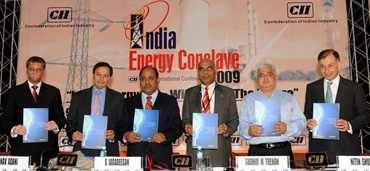CII A.T. Kearney Study on 'Sustaining Growth: Future of Indian Power Sector’
Mumbai, Source: Business Standard
|
“About $ 250 Bn investments would be needed in the power sector over the next 8-9 years”, according to a CII A.T. Kearney Study on `Sustaining Growth: Future of Indian Power Sector’. The study highlights the emerging opportunities and challenges in the future power markets.

Principal Secretary, Energy and Petrochemicals Department, Government of Gujarat, S. Jagadeesan (3rd L) hold up documents with Managing Director of Crompton Greaves Ltd Sudhir Trehan (3rd R), Chairman CII Gujarat State Council and Managing Director Adani Wilmar Ltd. Pranav Adani (2nd L), Partner and Vice President of A.T. Kearney Ltd. Kaustav Mukherjee (L), Group Chief Executive Officer of Shell Hazira Gas Nitin Shukla (2nd R), and Chairman CII Western Region and Director, Forbes Marshall Pvt. Ltd. Naushad Forbes (R) at the 'Energy Expo 2009' in Ahmedabad on October 9, 2009. Principal Secretary, Energy and Petrochemicals Department, Government of Gujarat, S. Jagadeesan inaugurated the 'Energy Expo 2009' which will conclude on October 11, 2009.
|
The Indian power market is evolving rapidly from a “nascent/ opening” market phase to a “developing” phase. The power demand in the base case is expected to grow at a steady 7.5%-8% CAGR till 2017. Further, the low “power penetration” levels indicate large latent/unmet demand. The power markets will have to achieve consistent high growth rates to bring our per capita consumption to comparable levels of some of the other developing countries like China and Brazil.
Sudhir Trehan, Chairman - CII India Energy Conclave & Energy Expo and Managing Director, Crompton Greaves said, “The emerging dynamics of the Indian power market would require industry players to realign their strategies and operating models to the changing sectoral trends”. “The focus would need to be both on project execution as well as efficient operations, in line with the ‘growth’ characteristics of the sector”, Mr Trehan added.
A.T. Kearney Partner, Kaustav Mukherjee said, “A new era of ‘Power on Power’ competition will emerge by the year 2014 that will bring in at least 80-85 GW of new capacity - 80- 90% of them thermal units targeting high PLF of 80-95% - reducing the base load deficit to a low of 1-2%”. “Accordingly, we expect pricing pressures in the generation space and a 40-50% decline in average short term/merchant prices by 2014-15”, Mr Mukherjee added.
The Report highlights new business opportunities will arise across the value chain. Gas, Hydro and Nuclear energy will renewed interests and growth in addition to coal, which will continue to be the dominant generation fuel. Renewables will strengthen its role in the sector: Wind energy will continue to grow at 15-20% pa with new opportunities in offshore capacities and large capacity turbines (> 3MW). Government incentives will open up opportunities for solar farms/distributed generation as well as PV manufacturing.
However, constrained fuel supplies present a major threat to the sector’s growth: As per current trajectory, India, in spite of substantial reserves, is expected to confront a supply deficit of ~25% (250 MTPA) of domestic coal by 2014. Similarly, there will be a seven fold increase in uranium requirement for meeting nuclear power ambitions of India. Distribution, financing and manpower are other concerns that require immediate attention: High AT&C losses and slow rate of discom reforms will hurt the industry in the last mile. Financing may also present a challenge to industry growth. About $ 250 Bn investments will need to be undertaken in the power sector in the next 8-9 years to fuel the planned growth. Similarly, over 150,000 additional skilled and semi skilled personnel required over the next 5 - 7 years.
In the emerging power scenario context, the study has highlighted some critical success factors for the industry
- Strengthen project management & execution capabilities, to ensure on-time, at cost execution.
- Secure fuel supplies through well defined fuel sourcing plan especially coal (linkage, captive, imported) and its associated costs. Fuel logistics planning and implementation is also critical and should be a focus for project leadership.
- Realign market & customer strategy, by striking the right balance between long term PPAs and merchant trading. Reforms will also give rise to customer mix options (SEBs, traders, bulk buyers, etc), which will open up different possibilities. Alternate market facing models like power tolling, distributed generation, peaking power supplies should also be evaluated.
- Develop Capital and Operational excellence through selection of right technology and suppliers/manufacturers for the units. The asset availability and utilisation should be maximized through O&M best practices.
- Establish robust organizational enablers, across people –processes and systems. Many organisations will have to manage concurrent “projects” and “operations” stages. Accordingly, a flexible organisation structure should to be designed and implemented.
Overall, the report is cautiously “optimistic” about the Indian Power Sector and its ability to support India’s growth aspirations. Effective implementation of next generation reforms, addressed constraints in fuel, financing and distribution and improved access & reach of Power / realisation of latent demand will ensure sustained growth of the sector and enable REAL “Power for All”! |
India's global trade in goods and services rises to 54% of GDP
New Delhi, Source: IBEF
|
|
India's global trade engagement has risen to account for 54 per cent of the country’s Gross Domestic Product (GDP) in 2008-09, from 30.9 per cent in 2003-04—an indication of increased integration with the global economy. In its paper on the state of the economy, the Finance Ministry said, “India's greater integration with the world economy is reflected in the trade openness indicator.” India’s merchandise trade rose from 23.7 per cent of the GDP in 2003-04 to 41 per cent in 2008-09. The paper said, "If the services trade is included, the indicator is higher at 54.2 per cent in 2008-09, reflecting greater degree of openness.” CRISIL's Principal Economist D K Joshi said, “In the last 4-5 years our exports and imports are growing phenomenally...Increasing external trade reflects India's greater openness. However, the ongoing global economic crisis has briefly interrupted the integration of India with the world economy.” |
Economic Indicators October 2009
|
- Annual WPI inflation rate for the week ending 17th Oct’09 stood at 1.51% as compared to previous week’s level of
1.21%.
- The revised inflation rate for the week
ending August 22, 2009 stood at 0.17% as
against –0.21%, reported earlier.
- Foreign Exchange Reserves as on 23rd
Oct’09 stood at US $285.5 billion, up by
US$ 684 million over the previous week.
- The call money rates as on 30th Oct’09
traded in the range of 2.00 – 3.30 percent.
- One year LIBOR for US$ as on 28th Oct’ 09 stood at 1.20%.
- At the Treasury bills auctions held
during the week, the YTM for 91–day TBills
stood at 3.2%.
- Six core sector industries registered a
4.0% growth in September, sharply lower
than the 7.8% in the month before. On a
cumulative basis, the core sector index
was up 5.0% during first six months of
the year, higher than the 3.4% growth
seen during the same period last year.
- The Consumer Price Index based inflation for Industrial workers fell to
11.64% in September as against 11.72%
in August.
|
|
Trade volumes drop
India’s exports during the period from April to August 2009 fell to US $ 64.12 billion as against figure US $ 92.95 billion during the corresponding period of the previous year, thus registering 31 % decrease in dollar terms. Similarly India’s imports during the same period decreased to US $ 102.3 billion as against the figure of US $ 153.69 billion during the corresponding period of the previous year, thus showing a negative growth of 33.4 %. The total trade decreased by US $ 79.22 billion during the current financial year ; however the trade deficit decreased to 38 billion during this period, mainly on account of lesser import bill which was caused by the fall in the international price of oil. |
Pharma exports surge in 2008 - 09
India’s export of pharmaceuticals and fine chemicals grew by 29 % in 2008 -2009 and stood at Rs. 395 billion. Pharmaceutical sector has emerged as one of the major contributors to the Indian export kitty and has shown a Compounded Annual Growth Rate (CAGR) of 17.8% during the five year period from 2003 – 04 to 2007 – 08. Recognizing the immense contribution made by this sector to the economy Mr. Anand Sharma, Commerce and Industries Minister in the Union Govt. announced that following benefits would be extended to the industry through the foreign trade policy: Additional resources would be made available under the market development assistance scheme and market access initiative scheme
Funds have been ear marked for brand promotion of Indian pharma industry in Africa
Pharma sector would benefit from increasing incentives under focus market and focus product schemes
Zero duty has been introduced under Export Promotion Capital Goods (EPCG) scheme for aiding technological up gradation for pharma sector also. |
Car exports to EU up by
36 pEr cent

Car exports from India in the first half of this fiscal jumped by 35.73 per cent as major manufacturers. Like Hyundai Motor India and Maruti Suzuki cashed in on scrappage incentives provided in Europe, despite other segments of the auto industry witnessing decline. According to the Society of Indian Automobile Manufacturers Association (SIAM), car exports during April-September stood at 2,10,088 units as against 1,54,783 units in the year-ago period.The growth in exports was driven by the Maruti Suzuki India, as its overseas shipments rose over two-fold during April- September to 65,752 units from 29,699 units in the year-ago period, SIAM said.
Hyundai Motor India reported 16.02 percent jump in exports at 1,39,971 units against 1,20,648 units in the same period last year. The momentum is expected to be sustained should respective governments in the European Union maintain their allocated funds under the scrappage scheme. |
India attracts US$ 3.47 billion FDI in July 2009
India attracted US$ 3.47 billion foreign direct investment (FDI) in July 2009, compared to US$ 2.24 billion in July 2008, according to official data. The country's total FDI inflow during April-July 2009 stood at US$ 10.49 billion. The services sector invited a significant 20 per cent of the total FDI inflow during April-July 2009. The country received US$ 2.14 billion FDI in services during the period, the highest among all sectors. The housing and real-estate attracted US$ 1.41 billion in investments while the telecommunications sector attracted investments worth US$ 993 million. According to official data, the highest FDI contribution of US$ 4.55 billion came from Mauritius, followed by the US and Singapore during the period. To facilitate foreign investment, the government has recently approved formation of an investment promotion firm ‘Invest India’ that will partner with the states and the industry to provide foreign investors a hassle-free entry.
Source: IBEF |
|